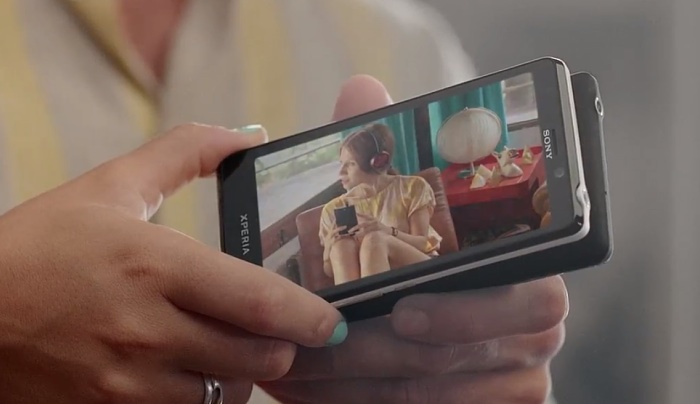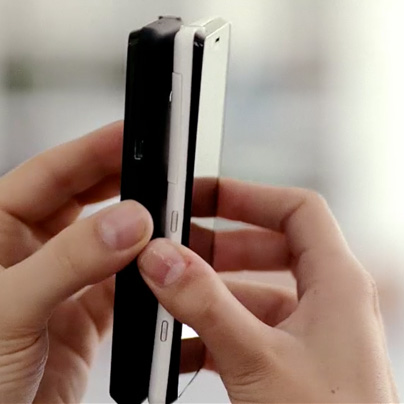
All looks idyllic, doesn't it? These images lifted from a Sony Xperia TV advert, showing what can be done in terms of NFC sharing by just 'tapping' phones...
You see, there are issues, physical issues, with siting the NFC antenna slap on the back of a phone (i.e. just under the battery cover or even part of the battery). I can absolutely understand why the antenna is put here - it can be nice and big (so better RF performance) and what could be more intuitive that laying your phone on top of a tag or accessory in order to interact with it?
However, with today's touchscreen phones getting thinner and larger (in plan area), it's getting harder and harder to hold them securely. You'll know the syndrome if you've carried something like a Samsung Galaxy Nexus or S II or S III around for a while - it's so easy to drop unless you hold it very securely. And something you really don't want to do is hold such a device gingerly on its edges with thumb and fingers - it's asking for trouble.
At which point it dawned on me that one of the most trumpeted uses of NFC, that of transferring content (e.g. a contact, a URL, a photo, a playlist) from one phone to another, is broken - physically. Here's another still from the Sony Xperia advert, showing two users happily touching phones to transfer something:

You can see the problem with NFC antennas in the backs of the phones. It all looks so effortless in the advert, but in reality you'll have two people both not wanting to drop their expensive smartphones on the pavement below, trying to brace them as best they can with minimal grip, with a possible 'bump' shock between the two devices also adding to the danger. It's not an operation that's particular pleasant to take part in and the users involved are likely to not think 'Wow, that was cool, I just used NFC for something useful', but rather 'Phew! I managed to get NFC to work and I didn't drop my phone!'

So, if the NFC antennae in the Nokia 808 and just about every Android-powered smartphone are badly placed, what do I suggest instead?
I'm glad you asked. Maybe you remember the late 1990s and early 2000s, when people used to transfer content between their PDAs (typically Palm and Psion at the time) using infrared. This worked in much the same way as Bluetooth but involved the users lining up the infrared windows on their devices, about six inches apart - and it all worked rather well, from both a technical and ergonomic standpoint.
Now, I'm not advocating a return to the days of infrared (you'll be glad to know), but the idea of two people aiming their devices at each other, or in NFC's case, touching each other, end to end, seems a hundred times more natural than forcing a precarious change of grip just to get two RF-weak antennae finding each other.
With NFC antennae in the top end of a phone, each person can retain a perfectly normal, and secure, grip on their device, the two bits of hardware are allowed to touch end to end and the NFC magic happens.
At this point, the cynics will say "Ah, but you can't put the NFC antenna in the top of a phone, there's not enough space!". To which point I bring out the Nokia C7 and 701 and 700, all with their NFC loops mounted internally near the top-rear of the device, such that the aforementioned end-to-end tap is sufficient for NFC detection and connection to happen. So it can be done, and on much smaller devices than some of the Android-powered behemoths.
With NFC seemingly always a year from the mass market, with body blows like the fractured state of mobile payments and Apple not including NFC in the latest iPhone, having manufacturers make a simple but hugely important ergonomic error seems the last thing that's needed.
Here's to end-to-end tapping, anyway. My phone will be the one without the dents and scratches....
No hay comentarios:
Publicar un comentario